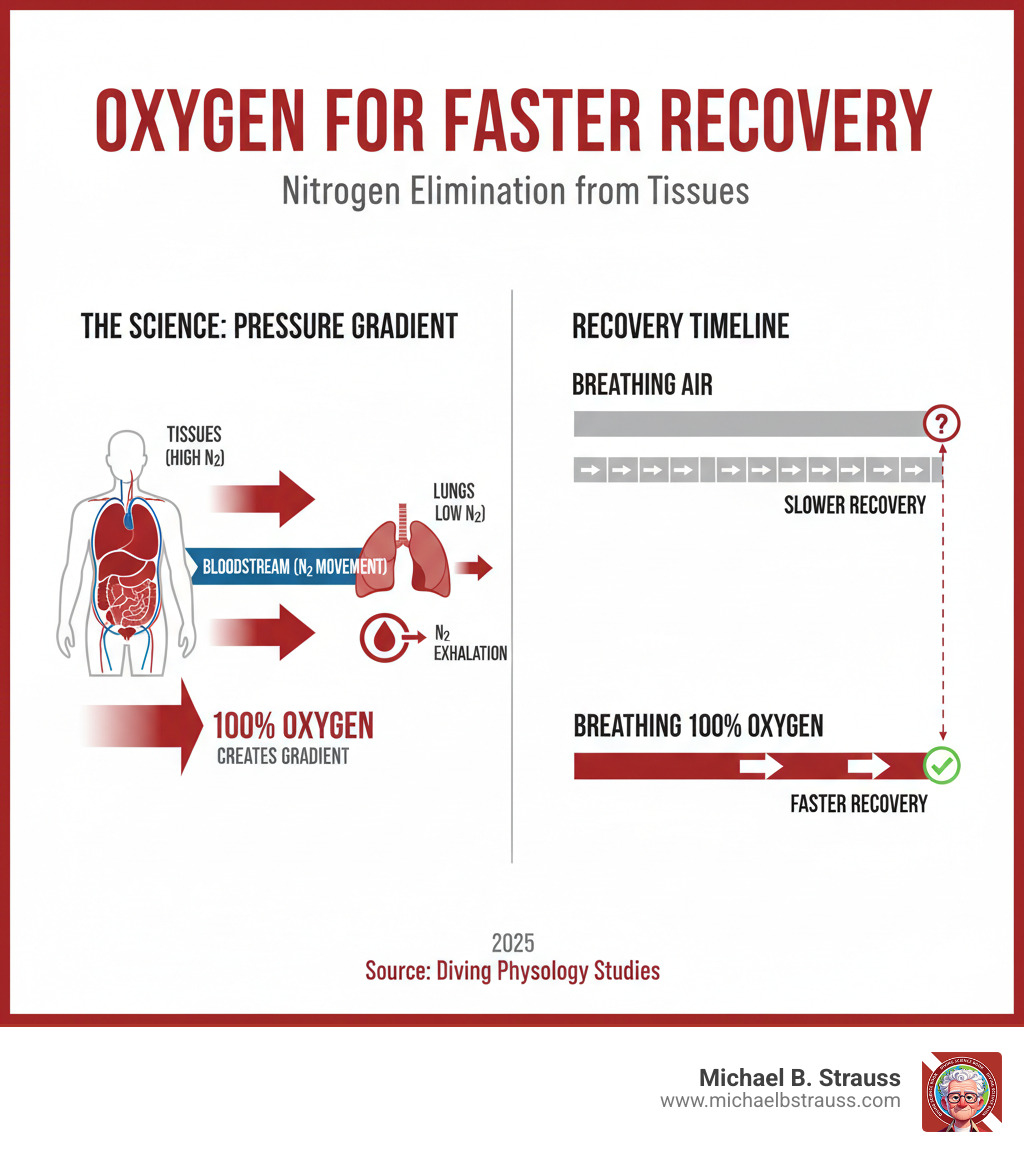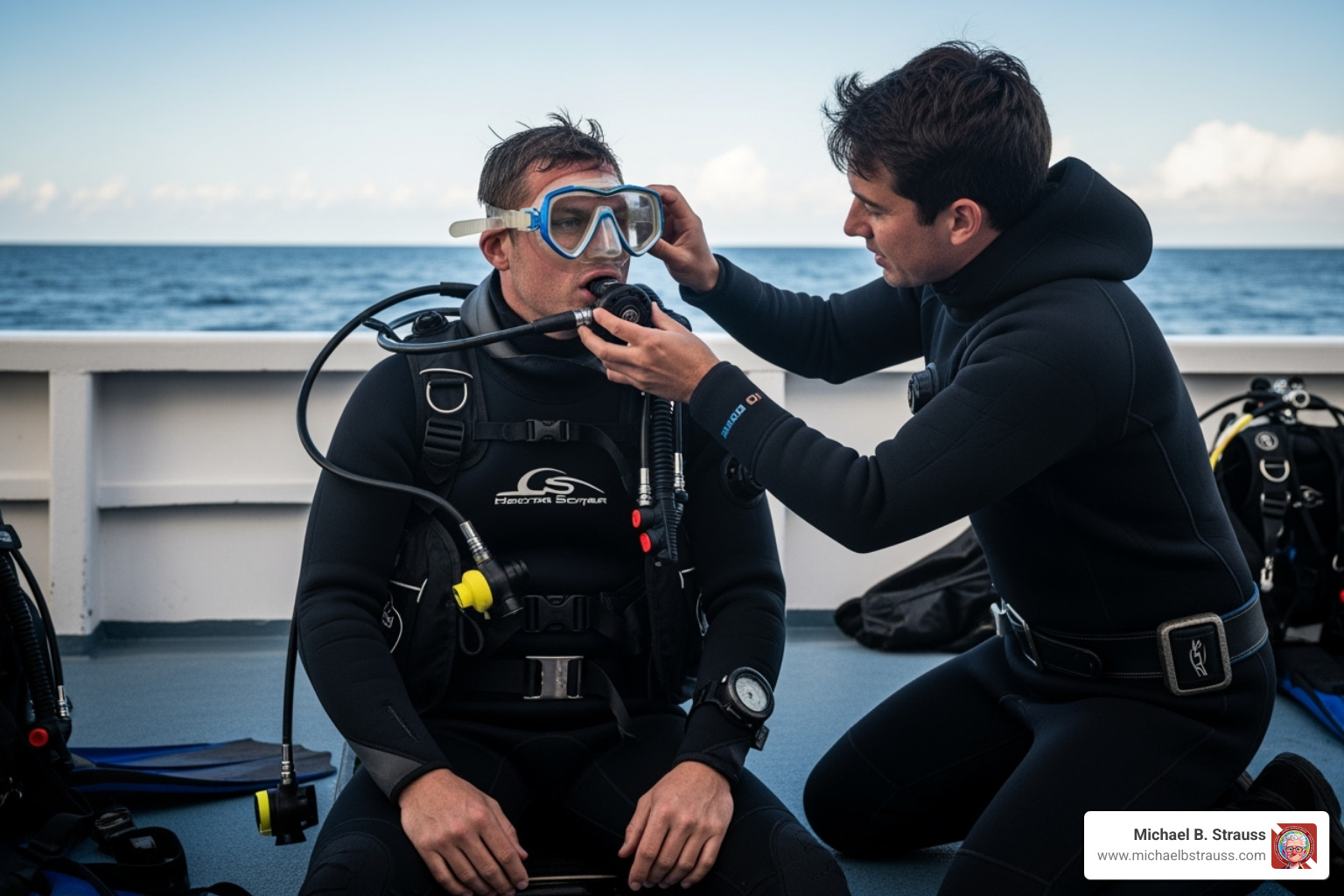Why Emergency Oxygen is a Diver's Best Friend
A diver emergency oxygen kit is a lifeline, delivering 100% oxygen to treat serious diving injuries like Decompression Sickness (DCS) and Arterial Gas Embolism (AGE). For these conditions, immediate oxygen administration is the undisputed standard of first aid. As one expert notes: *"Emergency oxygen is the preferred treatment for most scuba diving injuries, and early administration can drastically improve the outcome for an injured diver."
The science is straightforward. Breathing pure oxygen creates a steep pressure gradient that accelerates the removal of harmful nitrogen from body tissues—a process called nitrogen off-gassing. This helps alleviate DCS symptoms and promotes tissue re-oxygenation, improving circulation and helping oxygen-starved tissues recover faster. This principle dates back to the 1800s, when French physiologist Paul Bert used pure oxygen to treat caisson workers with decompression symptoms.

Dive injuries like lung barotrauma or near drowning severely impair the body's ability to use oxygen. Providing high-concentration oxygen can significantly reduce tissue damage and dramatically improve an injured diver's chance of a full recovery. Whether you're diving in remote locations or leading a group, immediate access to emergency oxygen can mean the difference between a minor incident and a serious medical emergency. To learn more about the intricacies of decompression sickness, we encourage you to read Why and at What Sites Decompression Sickness Can Occur.
The Core of Your Diver Emergency Oxygen Kit
Now that we understand why a diver emergency oxygen kit is a lifesaver, let's explore its components. Understanding your equipment is key to acting confidently in an emergency.

Key Components and Oxygen Duration
A standard kit includes several core components:
- Oxygen Cylinder: The heart of the system, typically lightweight aluminum, in sizes from compact M9 units to larger Jumbo D cylinders for extended operations.
- Regulator: Reduces the cylinder's high pressure to a safe, breathable level. It must be rated for oxygen service and includes a pressure gauge to monitor supply.
- Delivery Devices: A non-rebreather mask delivers high-concentration oxygen to conscious, breathing divers, while an oronasal resuscitation mask can be used for both conscious and non-breathing divers.
- Carrying Case: A sturdy, waterproof, and shockproof case protects your kit from the elements and impacts.
- Pulse Oximeter: A small, noninvasive device that clips to a finger to measure blood oxygen saturation, providing valuable feedback on the treatment's effectiveness.
Oxygen duration depends on cylinder size and flow rate, typically 10-15 liters per minute (lpm).
| Cylinder Type | Total Gas Volume | Duration @ 15 lpm | Duration @ 10 lpm |
|---|---|---|---|
| M9 (MC) | 255 liters | 15 minutes | 23 minutes |
| M22 (Jumbo D) | 623 liters | 39 minutes | 58 minutes |
| M24 (ME) | 680 liters | 44 minutes | 66 minutes |
Choosing the Right Diver Emergency Oxygen Kit
Selecting a kit isn't a one-size-fits-all decision. Consider these factors:
- Dive Type & Location: Remote shore dives or technical diving demand more self-sufficiency and larger oxygen supplies than boat dives near medical facilities.
- Travel Time to Care: The farther you are from help, the more oxygen you need. A 15-minute supply may not be enough for a two-hour boat ride to shore.
- Number of Divers: A divemaster leading a group needs more capacity than a solo diver or buddy pair.
- Redundancy: Even if a boat has a kit, a personal kit provides crucial backup.
- Portability: A compact, lightweight kit is more likely to be brought on every dive.
For deeper insights into the science behind these considerations, explore Decompression Science.
Understanding Oxygen Delivery Systems
Different situations require different delivery devices:
- For conscious, breathing divers: A non-rebreather mask is ideal, delivering 90-100% oxygen at 10-15 lpm. A demand valve, which provides oxygen only on inhalation, is another option that conserves supply.
- For unconscious or non-breathing divers: A manually triggered ventilator (MTV) is the first choice, delivering nearly 100% oxygen during CPR. A bag valve mask (BVM) is another effective option. A basic CPR pocket mask is least effective but can be improved by adding an oxygen input.
Administering Oxygen: Training and Best Practices
Owning a kit is not enough; proper training is essential.

An Emergency O2 Provider course provides hands-on practice with kit assembly, patient assessment, and delivery techniques. Key practices include:
- Conscious Diver: Use a non-rebreather mask at 10-15 lpm and monitor the patient.
- Unconscious/Non-Breathing Diver: Follow ABCs (Airway, Breathing, Circulation). Use an MTV to deliver 100% oxygen breaths (about one second each) during CPR. If the patient is breathing, a non-rebreather mask is appropriate.
- Airway Management: Proper head positioning and mask seal are critical to ensure oxygen reaches the lungs.
You don't need a perfect diagnosis to begin treatment. Early oxygen administration is safe and beneficial for nearly all diving-related injuries. For more on diving medicine, see Evaluation and Management of Pain-Related Medical Problems of Diving.
Logistics, Legality, and Long-Term Care
Your diver emergency oxygen kit is critical dive gear that requires the same care as your regulator or BCD. This section covers the practical side of ownership, from maintenance to navigating regulations, ensuring your kit is always ready.
Maintenance, Storage, and Transport
Regular maintenance is straightforward but essential for reliability.
- Periodic Testing: Oxygen cylinders require hydrostatic testing and a visual inspection approximately every five years to ensure they are structurally sound.
- Regulator Servicing: Have your oxygen regulator serviced every two years to keep it functioning accurately.
- Pre-Dive Checks: Before each trip, confirm all contents are present, clean, and assembled. After use, replace single-use items and disinfect reusable parts.
- Avoid Contaminants: Keep the kit free from dirt, grease, and oil, as these can be fire hazards with high-concentration oxygen.
For storage and transport, store the kit in a cool, dry place away from direct sunlight. Never leave a pressurized cylinder in a hot car. When transporting, secure the kit firmly to prevent impact damage; its shockproof, waterproof case is designed for this purpose.
Refills and Regulations for Your Diver Emergency Oxygen Kit
Understanding refills and regulations is simpler than it seems.
- Getting Refills: Most compressed gas suppliers can provide refills. In the U.S., FDA rules permit filling cylinders with USP grade oxygen (United States Pharmacopeia) without a prescription if the cylinder is labeled "OXYGEN Emergency Use Only."
- Legal Landscape: Always insist on USP grade oxygen. Be aware that regulations, especially for labeling and prescriptions, can vary significantly outside the U.S. Research the rules for your destination before traveling internationally with your kit.
- Transport Rules: Air travel with oxygen is highly restricted and requires special arrangements. For ground transport, always secure the cylinder properly in your vehicle.
For a comprehensive guide to the science behind safe diving, get your copy of Diving Science Revisited.
DISCLAIMER: Articles are for "EDUCATIONAL PURPOSES ONLY", not to be considered advice or recommendations.






